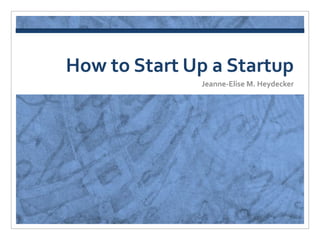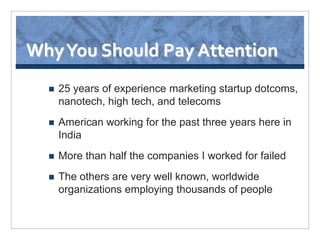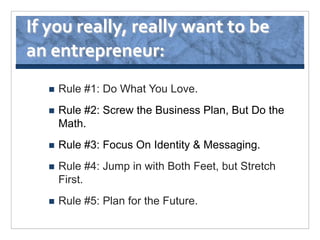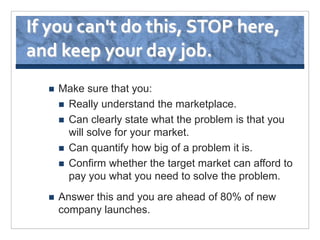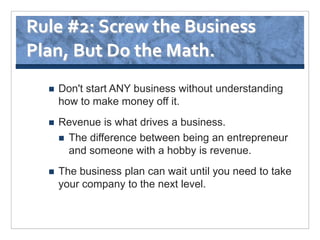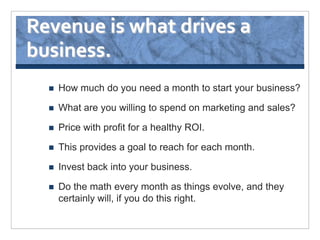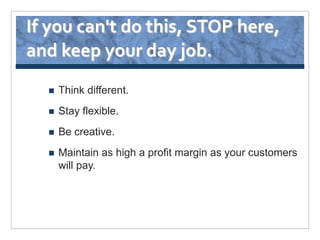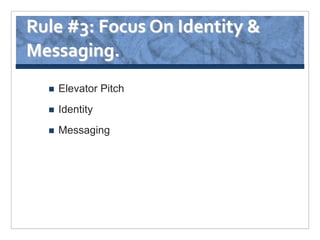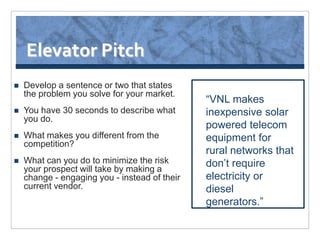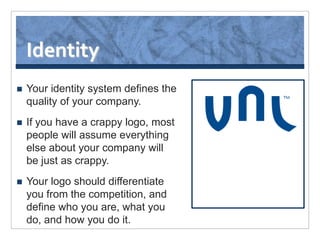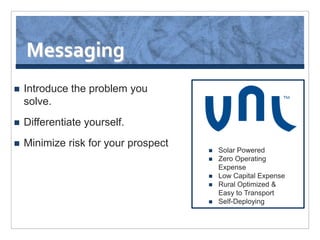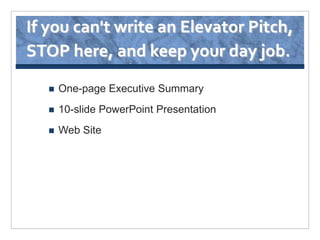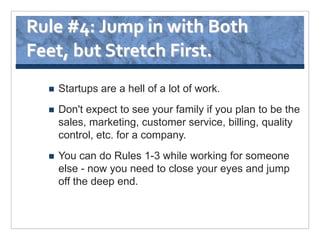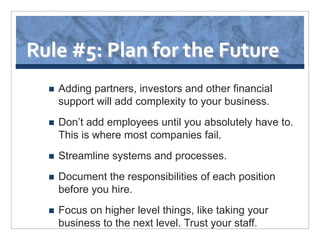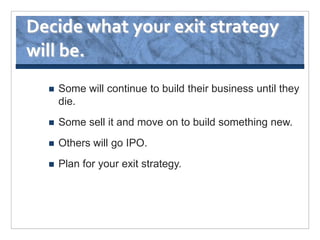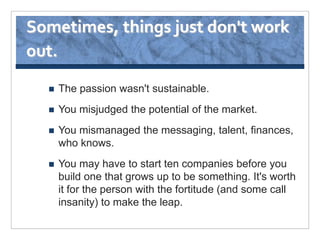How to Start Up a Startup
- 1. How to Start Up a Startup Jeanne-Elise M. Heydecker
- 2. Why You Should Pay Attention ’ü« 25 years of experience marketing startup dotcoms, nanotech, high tech, and telecoms ’ü« American working for the past three years here in India ’ü« More than half the companies I worked for failed ’ü« The others are very well known, worldwide organizations employing thousands of people
- 3. If you really, really want to be an entrepreneur: ’ü« Rule #1: Do What You Love. ’ü« Rule #2: Screw the Business Plan, But Do the Math. ’ü« Rule #3: Focus On Identity & Messaging. ’ü« Rule #4: Jump in with Both Feet, but Stretch First. ’ü« Rule #5: Plan for the Future.
- 4. Rule #1: Do What You Love. ’ü« Why do you want to start a company? ’ü« Being engaged on an emotional level gives you better odds on succeeding. ’ü« If you're doing what you love to do, getting a paycheck for it is like getting two desserts.
- 5. If you can't do this, STOP here, and keep your day job. ’ü« Make sure that you: ’ü« Really understand the marketplace. ’ü« Can clearly state what the problem is that you will solve for your market. ’ü« Can quantify how big of a problem it is. ’ü« Confirm whether the target market can afford to pay you what you need to solve the problem. ’ü« Answer this and you are ahead of 80% of new company launches.
- 6. Rule #2: Screw the Business Plan, But Do the Math. ’ü« Don't start ANY business without understanding how to make money off it. ’ü« Revenue is what drives a business. ’ü« The difference between being an entrepreneur and someone with a hobby is revenue. ’ü« The business plan can wait until you need to take your company to the next level.
- 7. Revenue is what drives a business. ’ü« How much do you need a month to start your business? ’ü« What are you willing to spend on marketing and sales? ’ü« Price with profit for a healthy ROI. ’ü« This provides a goal to reach for each month. ’ü« Invest back into your business. ’ü« Do the math every month as things evolve, and they certainly will, if you do this right.
- 8. If you can't do this, STOP here, and keep your day job. ’ü« Think different. ’ü« Stay flexible. ’ü« Be creative. ’ü« Maintain as high a profit margin as your customers will pay.
- 9. Rule #3: Focus On Identity & Messaging. ’ü« Elevator Pitch ’ü« Identity ’ü« Messaging
- 10. Elevator Pitch ’ü« Develop a sentence or two that states the problem you solve for your market. ŌĆ£VNL makes ’ü« You have 30 seconds to describe what inexpensive solar you do. powered telecom ’ü« What makes you different from the equipment for competition? rural networks that ’ü« What can you do to minimize the risk donŌĆÖt require your prospect will take by making a change - engaging you - instead of their electricity or current vendor. diesel generators.ŌĆØ
- 11. Identity ’ü« Your identity system defines the quality of your company. ’ü« If you have a crappy logo, most people will assume everything else about your company will be just as crappy. ’ü« Your logo should differentiate you from the competition, and define who you are, what you do, and how you do it.
- 12. Messaging ’ü« Introduce the problem you solve. ’ü« Differentiate yourself. ’ü« Minimize risk for your prospect ’ü« Solar Powered ’ü« Zero Operating Expense ’ü« Low Capital Expense ’ü« Rural Optimized & Easy to Transport ’ü« Self-Deploying
- 13. If you can't write an Elevator Pitch, STOP here, and keep your day job. ’ü« One-page Executive Summary ’ü« 10-slide PowerPoint Presentation ’ü« Web Site
- 14. Rule #4: Jump in with Both Feet, but Stretch First. ’ü« Startups are a hell of a lot of work. ’ü« Don't expect to see your family if you plan to be the sales, marketing, customer service, billing, quality control, etc. for a company. ’ü« You can do Rules 1-3 while working for someone else - now you need to close your eyes and jump off the deep end.
- 15. If youŌĆÖre unwilling to sacrifice, STOP here, and keep your day job. ’ü« Passion and Sacrifice go hand-in-hand at this point. ’ü« As an entrepreneur, you have to give up having a normal 9-5 job so you better enjoy what you're doing. ’ü« Your "work/life balance" is screwed for at least a year, usually three. ’ü« As your company grows, you can hire people to do the parts of the company you like the least.
- 16. Rule #5: Plan for the Future ’ü« Adding partners, investors and other financial support will add complexity to your business. ’ü« DonŌĆÖt add employees until you absolutely have to. This is where most companies fail. ’ü« Streamline systems and processes. ’ü« Document the responsibilities of each position before you hire. ’ü« Focus on higher level things, like taking your business to the next level. Trust your staff.
- 17. Decide what your exit strategy will be. ’ü« Some will continue to build their business until they die. ’ü« Some sell it and move on to build something new. ’ü« Others will go IPO. ’ü« Plan for your exit strategy.
- 18. Sometimes, things just don't work out. ’ü« The passion wasn't sustainable. ’ü« You misjudged the potential of the market. ’ü« You mismanaged the messaging, talent, finances, who knows. ’ü« You may have to start ten companies before you build one that grows up to be something. It's worth it for the person with the fortitude (and some call insanity) to make the leap.

